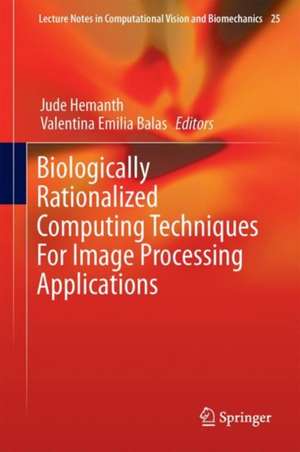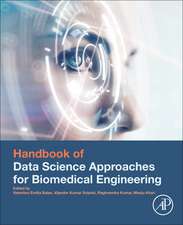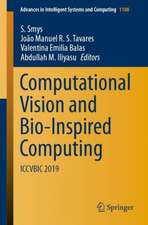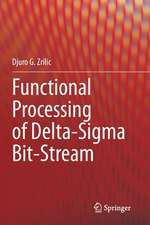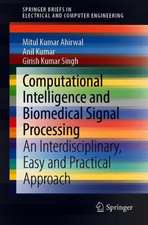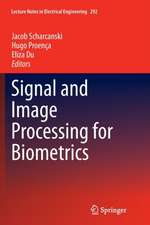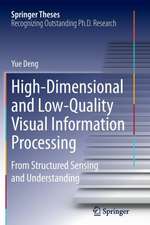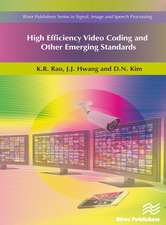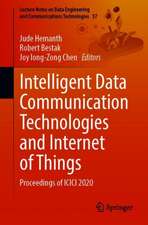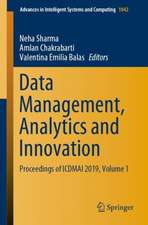Biologically Rationalized Computing Techniques For Image Processing Applications: Lecture Notes in Computational Vision and Biomechanics, cartea 25
Editat de Jude Hemanth, Valentina Emilia Balasen Limba Engleză Hardback – 18 aug 2017
This book introduces readers to innovative bio-inspired computing techniques for image processing applications. It demonstrates how a significant drawback of image processing – not providing the simultaneous benefits of high accuracy and less complexity – can be overcome, proposing bio-inspired methodologies to help do so.
Besides computing techniques, the book also sheds light on the various application areas related to image processing, and weighs the pros and cons of specific methodologies. Even though several such methodologies are available, most of them do not provide the simultaneous benefits of high accuracy and less complexity, which explains their low usage in connection with practical imaging applications, such as the medical scenario. Lastly, the book illustrates the methodologies in detail, making it suitable for newcomers to the field and advanced researchers alike.
| Toate formatele și edițiile | Preț | Express |
|---|---|---|
| Paperback (1) | 564.41 lei 38-44 zile | |
| Springer International Publishing – 7 aug 2018 | 564.41 lei 38-44 zile | |
| Hardback (1) | 651.19 lei 3-5 săpt. | |
| Springer International Publishing – 18 aug 2017 | 651.19 lei 3-5 săpt. |
Din seria Lecture Notes in Computational Vision and Biomechanics
- 5%
 Preț: 734.38 lei
Preț: 734.38 lei - 5%
 Preț: 1103.03 lei
Preț: 1103.03 lei - 5%
 Preț: 724.50 lei
Preț: 724.50 lei - 5%
 Preț: 714.63 lei
Preț: 714.63 lei - 20%
 Preț: 344.42 lei
Preț: 344.42 lei - 5%
 Preț: 720.10 lei
Preț: 720.10 lei - 5%
 Preț: 367.64 lei
Preț: 367.64 lei - 5%
 Preț: 731.43 lei
Preț: 731.43 lei - 15%
 Preț: 648.05 lei
Preț: 648.05 lei - 5%
 Preț: 725.07 lei
Preț: 725.07 lei - 5%
 Preț: 374.20 lei
Preț: 374.20 lei - 5%
 Preț: 735.11 lei
Preț: 735.11 lei - 5%
 Preț: 729.42 lei
Preț: 729.42 lei - 15%
 Preț: 647.40 lei
Preț: 647.40 lei - 5%
 Preț: 1100.30 lei
Preț: 1100.30 lei - 5%
 Preț: 374.57 lei
Preț: 374.57 lei - 15%
 Preț: 642.68 lei
Preț: 642.68 lei - 5%
 Preț: 380.80 lei
Preț: 380.80 lei - 5%
 Preț: 375.70 lei
Preț: 375.70 lei - 24%
 Preț: 888.75 lei
Preț: 888.75 lei -
 Preț: 483.05 lei
Preț: 483.05 lei - 20%
 Preț: 569.86 lei
Preț: 569.86 lei - 15%
 Preț: 652.31 lei
Preț: 652.31 lei - 5%
 Preț: 647.55 lei
Preț: 647.55 lei -
 Preț: 355.15 lei
Preț: 355.15 lei - 18%
 Preț: 971.32 lei
Preț: 971.32 lei -
 Preț: 363.67 lei
Preț: 363.67 lei - 5%
 Preț: 1122.42 lei
Preț: 1122.42 lei - 5%
 Preț: 1168.30 lei
Preț: 1168.30 lei - 5%
 Preț: 1031.90 lei
Preț: 1031.90 lei - 5%
 Preț: 1104.32 lei
Preț: 1104.32 lei - 5%
 Preț: 721.77 lei
Preț: 721.77 lei
Preț: 651.19 lei
Preț vechi: 766.10 lei
-15% Nou
Puncte Express: 977
Preț estimativ în valută:
124.62€ • 135.32$ • 104.68£
124.62€ • 135.32$ • 104.68£
Carte disponibilă
Livrare economică 01-15 aprilie
Preluare comenzi: 021 569.72.76
Specificații
ISBN-13: 9783319613154
ISBN-10: 3319613154
Pagini: 436
Ilustrații: VI, 337 p. 210 illus., 147 illus. in color.
Dimensiuni: 155 x 235 mm
Greutate: 0.72 kg
Ediția:1st ed. 2018
Editura: Springer International Publishing
Colecția Springer
Seria Lecture Notes in Computational Vision and Biomechanics
Locul publicării:Cham, Switzerland
ISBN-10: 3319613154
Pagini: 436
Ilustrații: VI, 337 p. 210 illus., 147 illus. in color.
Dimensiuni: 155 x 235 mm
Greutate: 0.72 kg
Ediția:1st ed. 2018
Editura: Springer International Publishing
Colecția Springer
Seria Lecture Notes in Computational Vision and Biomechanics
Locul publicării:Cham, Switzerland
Cuprins
Artifical Bee Colony Algorithm for Classification of Semi-Urban LU/LC Features Using High Resolution Satellite Data.- Saliency Based Image Compression Using Walsh–Hadamard Transform (WHT).- Object trajectory prediction with scarce environment information.- A Two-fold Subspace Learning Based Feature Fusion Strategy for Classification of EMG and EMG spectrogram Images.- Automatic Detection of Brain Strokes in CT Images using Soft Computing Techniques.- A survey on Intelligence based biometric techniques for authentication applications.- Spatial and Spectral Quality Assessment of Fused Hyperspectral and Multispectral Data.- Deep Learning Techniques for Breast Cancer Detection using Medical Images Analysis.- A Tour towards the development of various Techniques for Paralysis Detection using Image Processing.- Chlorella - Algae Image Analysis using Artificial Neural Network and Deep Learning.- Review on Image Enhancement Techniques
using Biologically Inspired Artificial Bee ColonyAlgorithms and its variants.- Certain Applications and Case Studies of Evolutionary Computing Techniques for Image Processing.- Histopathological Image Analysis for the Grade Identification of Tumor.- Super Resolution via Particle Swarm Optimization Variants.Notă biografică
D. Jude Hemanth received his B.E degree in ECE from Bharathiar University in 2002, M.E degree in communication systems from Anna University in 2006 and Ph.D. from Karunya University in 2013. His research areas include Computational Intelligence and Image processing. He has authored more than 100 research papers in well-respected international journals such as Neurocomputing, Neural Computing and Applications, Neural Network World, etc. as well as book chapters published by well known publishers. He is very active in his field, holding membership of professional organisations and serving on committees and boards. Currently, he is working as Associate Professor in the Department of ECE, Karunya University, Coimbatore, India.
Valentina E. Balas is currently Full Professor in the Department of Automatics and Applied Software at the Faculty of Engineering, “Aurel Vlaicu” University of Arad, Romania. She holds a Ph.D. in Applied Electronics and Telecommunication
s from Polytechnic University of Timisoara. Dr. Balas is author of more than 250 research papers in refereed journals and International Conferences. Her research interests are in Intelligent Systems, Fuzzy Control, Soft Computing, Smart Sensors, Information Fusion, Modeling and Simulation. She is the Editor-in Chief to International Journal of Advanced Intelligence Paradigms (IJAIP) and to International Journal of Computational Systems Engineering (IJCSysE), Editorial Board member of several national and international journals and is evaluator expert for national and international projects. Dr. Balas is the director of Intelligent Systems Research Centre in Aurel Vlaicu University of Arad. She served as General Chair of the International Workshop Soft Computing and Applications (SOFA) in seven editions 2005-2016 held in Romania and Hungary. Dr. Balas participated in many international conferences as Organizer, Honorary Chair, Session Chair and member in Steering, Advisory or International Program Committees. She is a member of EUSFLAT, SIAM and a Senior Member IEEE, member in TC – Fuzzy Systems (IEEE CIS), member in TC - Emergent Technologies (IEEE CIS), member in TC – Soft Computing (IEEE SMCS). Dr. Balas was Vice-president (Awards) of IFSA International Fuzzy Systems Association Council (2013-2015) and is a Joint Secretary of the Governing Council of Forum for Interdisciplinary Mathematics (FIM), - A Multidisciplinary Academic Body, India.Textul de pe ultima copertă
This book introduces readers to innovative bio-inspired computing techniques for image processing applications. It demonstrates how a significant drawback of image processing – not providing the simultaneous benefits of high accuracy and less complexity – can be overcome, proposing bio-inspired methodologies to help do so.
Besides computing techniques, the book also sheds light on the various application areas related to image processing, and weighs the pros and cons of specific methodologies. Even though several such methodologies are available, most of them do not provide the simultaneous benefits of high accuracy and less complexity, which explains their low usage in connection with practical imaging applications, such as the medical scenario. Lastly, the book illustrates the methodologies in detail, making it suitable for newcomers to the field and advanced researchers alike.
Caracteristici
Details workflows for each chapter, making it suitable for beginners Presents novel/modified computing algorithms, which will benefit advanced researchers Includes implementation details in every chapter to aid in understanding Includes supplementary material: sn.pub/extras
